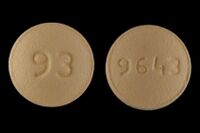Prochlorperazine
| Prochlorperazine | |||||||||||||||||||||||
|---|---|---|---|---|---|---|---|---|---|---|---|---|---|---|---|---|---|---|---|---|---|---|---|
 |
|||||||||||||||||||||||
| Chemical Nomenclature | |||||||||||||||||||||||
| Common names | Compazine, Stemzine, Buccastem, Stemetil, Phenotil | ||||||||||||||||||||||
| Systematic name | 2-chloro-10-[3-(4-methyl-1-piperazinyl)propyl]- 10H-phenothiazine | ||||||||||||||||||||||
| Class Membership | |||||||||||||||||||||||
| Psychoactive class | Antipsychotic | ||||||||||||||||||||||
| Chemical class | Phenothiazine | ||||||||||||||||||||||
| Routes of Administration | |||||||||||||||||||||||
|
|||||||||||||||||||||||
| Interactions | |||||||||||||||||||||||
Prochlorperazine (Compazine, Stemzine, Buccastem, Stemetil, Phenotil) is a dopamine (D2) receptor antagonist that belongs to the phenothiazine class of antipsychotic agents that are used for the treatment of nausea and vertigo. It is also a highly potent typical antipsychotic and is 10–20× more potent than chlorpromazine. It is also used to treat migraine headaches.[1]
Chemistry
Prochlorperazine is a piperazine derivative of the phenothiazine class of organic compounds. Prochlorperazine contains 1-methyl-4-propyl-piperazine bound to its phenothiazine group. The tricylcic phenothiazine group contains two phenyl rings bound to a thiazine. Prochlorperazine is found in pills as a maleate. It is analagous to chlorpromazine, another anti-psychotic phenothiazine.
Pharmacology

Prochlorperazine is thought to exert its antipsychotic effects by blocking dopamine receptors.[2]
Prochlorperazine is analogous to chlorpromazine; both of these agents antagonize dopaminergic D2 receptors in various pathways of the central nervous system. This D2 blockade results in antipsychotic, antiemetic and other effects.
Subjective effects
The effects listed below are based upon the subjective effects index and personal experiences of PsychonautWiki contributors. The listed effects will rarely if ever occur all at once but heavier dosages will increase the chances and are more likely to induce a full range of effects.
Physical effects
The physical effects of prochlorperazine can be broken down into several components all of which progressively intensify proportional to dosage. These are described below and generally include:
Cognitive effects
The general head space of prochlorperazine is often described as one of sleepiness, emptiness, apathy, stupor and catatonia. The specific cognitive effects can be broken down into 6 components all of which progressively intensify proportional to dosage. These are described below and generally include:
- Thought deceleration
- Emotion suppression
- Information processing suppression
- Language suppression
- Amnesia
- Anxiety suppression
Toxicity and harm potential
Nervous system side effects have been associated with the use of prochlorperazine. Extrapyramidal side effects such as acute dystonic reactions, pseudoparkinsonism, or akathisia can affect 2% of patients at low doses, whereas higher doses may affect as many as 40% of patients.[3][4]
Prochlorperazine can also cause a life-threatening condition called neuroleptic malignant syndrome (NMS). Some symptoms of NMS include a high fever, stiff muscles, confusion, irregular pulse or blood pressure, a fast heart rate (tachycardia), sweating, or irregular heart rhythms (arrhythmias).
Lethal dosage
The lethal dosage of this compound is unknown. Symptoms of overdose, however, may include agitation, coma, confusion, difficulty breathing, fainting, irregular heartbeat, loss of consciousness, muscle spasms, uncontrolled muscle movements, restlessness, seizures, severe constipation, stomach pain, severe drowsiness, dizziness, tremors, or trouble urinating.
Tolerance and addiction potential
As with other antipsychotics, long term use can be considered addictive and is capable of causing both physical and psychological dependence. When physical dependence has developed, withdrawal symptoms may occur if a person suddenly stops their usage.
Legal issues
- UK: The drug is available over the counter and as a prescription medication.
- USA: Prochlorperazine is available only through prescription.
- Australia: The substance is available only through prescription.
See also
References
- ↑ Husseini, A; Gianakos, D (February 2006). "The 15-Minute Visit". Patient Care 40: 9–10.
- ↑ Manuchair S. Ebadi, Desk reference of clinical pharmacology. 2007
- ↑ Psychiatric Side Effects of Prescription and Over-the-counter Medications | http://books.google.com.au/books?id=K7kevbILCuQC&source=gbs_navlinks_s
- ↑ http://www.drugs.com/sfx/procot-side-effects.html